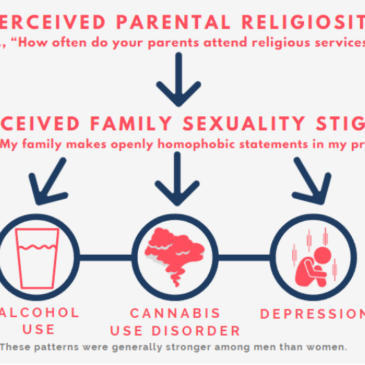Social stigma and discrimination are common experiences for many communities. Stigma and discrimination are risk factors for substance use and might contribute to elevated rates of substance use in many minoritized communities. Studies on the effects of stigma on substance use among LGBTQ+ people have identified stigma within religious families as a complex situation. Expanding our understanding of how different stigmas interact and manifest is important for preventing substance misuse. Therefore, this week STASH reviews a study by Ashley Macbeth and colleagues that tests a mediation model of stigma, religiosity, and substance use.
What was the research question?
Does parental religiosity predict LGBTQ+ substance use and depression through the mediator of perceived family stigma?
What did the researchers do?
The researchers surveyed 427 individuals who identify as LGBTQ+ on their experiences with familial stigma of their sexuality and perceptions of their parents’ religiosity. Next, participants completed measures of alcohol use, likelihood of having cannabis use disorder, and past week experiences of depression. The researchers tested a model that assessed the role of perceived familial stigma of sexuality as a mediator in the relationship between parent religiosity and LGBTQ+ substance use and depression. Additional analyses examined whether these patterns differed between men and women.
What did they find?
Participants with higher perceived parental religiosity were more likely to use alcohol, have cannabis use disorder, and have past week experiences of depression. Perceived family stigma of sexuality was an important mediator in this relationship. More specifically, perceived parental stigma fully explained the relationship between parental religiosity and depression and cannabis use disorder and partially mediated the relationship between perceived parental religiosity and alcohol use (see Figure). Additionally, the researchers found that gender moderated this relationship; these relationships were stronger for men than women, except in the relationship between perceived family stigma of sexuality and the likelihood of having cannabis use disorder, which was stronger among women.
Figure. Illustrates the downstream effects of parental religiosity on the measured outcomes. Perceived parental religiosity was associated with perceived family sexuality stigma, which was then associated with the likelihood of alcohol use, cannabis use disorder, and depression. Click image to enlarge.
Why do these findings matter?
These findings are important for crafting effective substance use interventions for the LGBTQ+ community. While many substance use treatment organizations, such as Alcoholics Anonymous center spirituality in the healing process, this may be a difficult reconciliation for LGBTQ+ members who carry religious traumas. Additionally, these findings imply that previous familial trauma could be an important target when working with LGBTQ+ clients struggling with addiction.
Every study has limitations. What are the limitations in this study?
This study relied on participants to represent their parents’ religiosity. Participants may not have an accurate view of all facets of a parents’ religiosity. Also, this study measured perceptions of parents’ overt religious actions and habits, but parents’ private religious/spiritual beliefs might also play a role in family stigma and children’s well being. Additionally, while the study employed a large sample, it was too small to examine more nuanced differences between sexual and gender identities.
For more information:
The Trevor Project is an organization dedicated to supporting LGBTQ+ youth. LGBTQ+ individuals and their families may also benefit from Pflags family resources. Additional resources can be found at the BASIS Addiction Resources page.
— John Slabczynski
What do you think? Please use the comment link below to provide feedback on this article.





